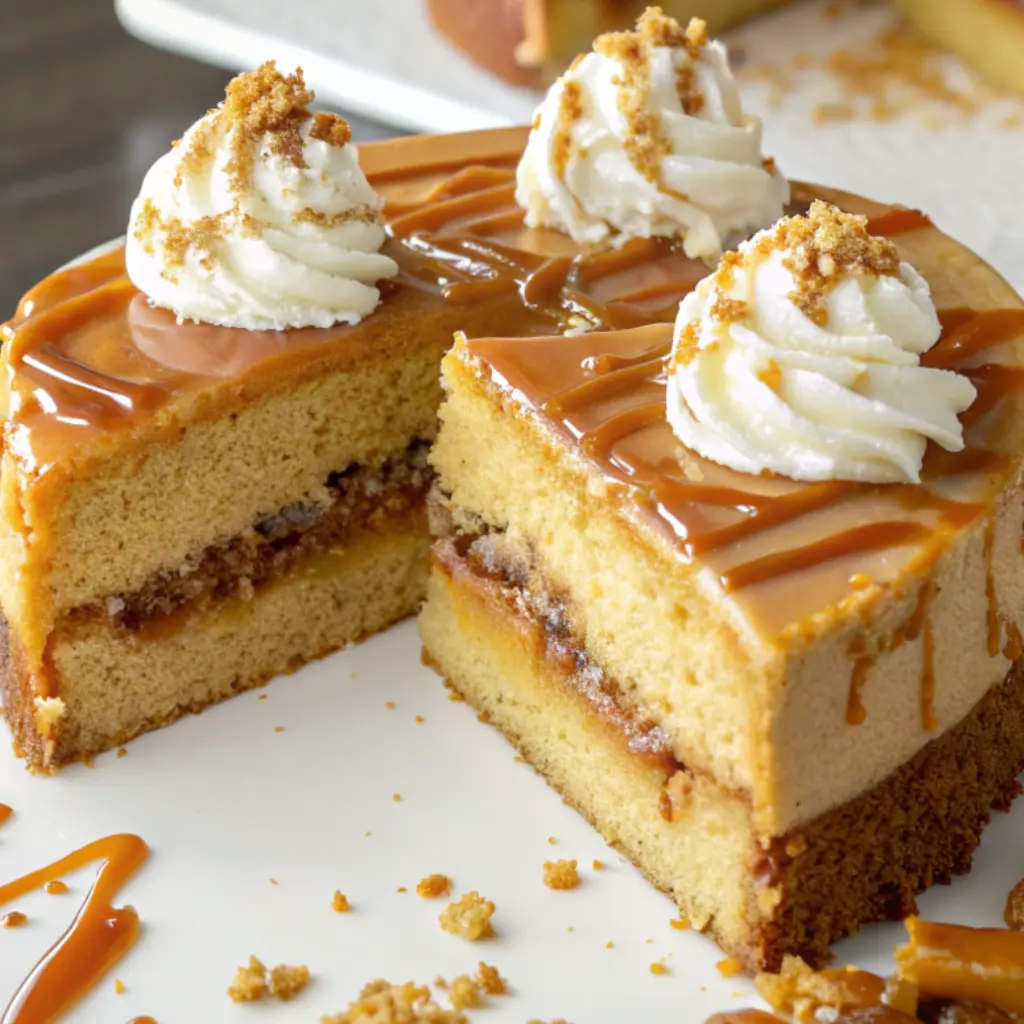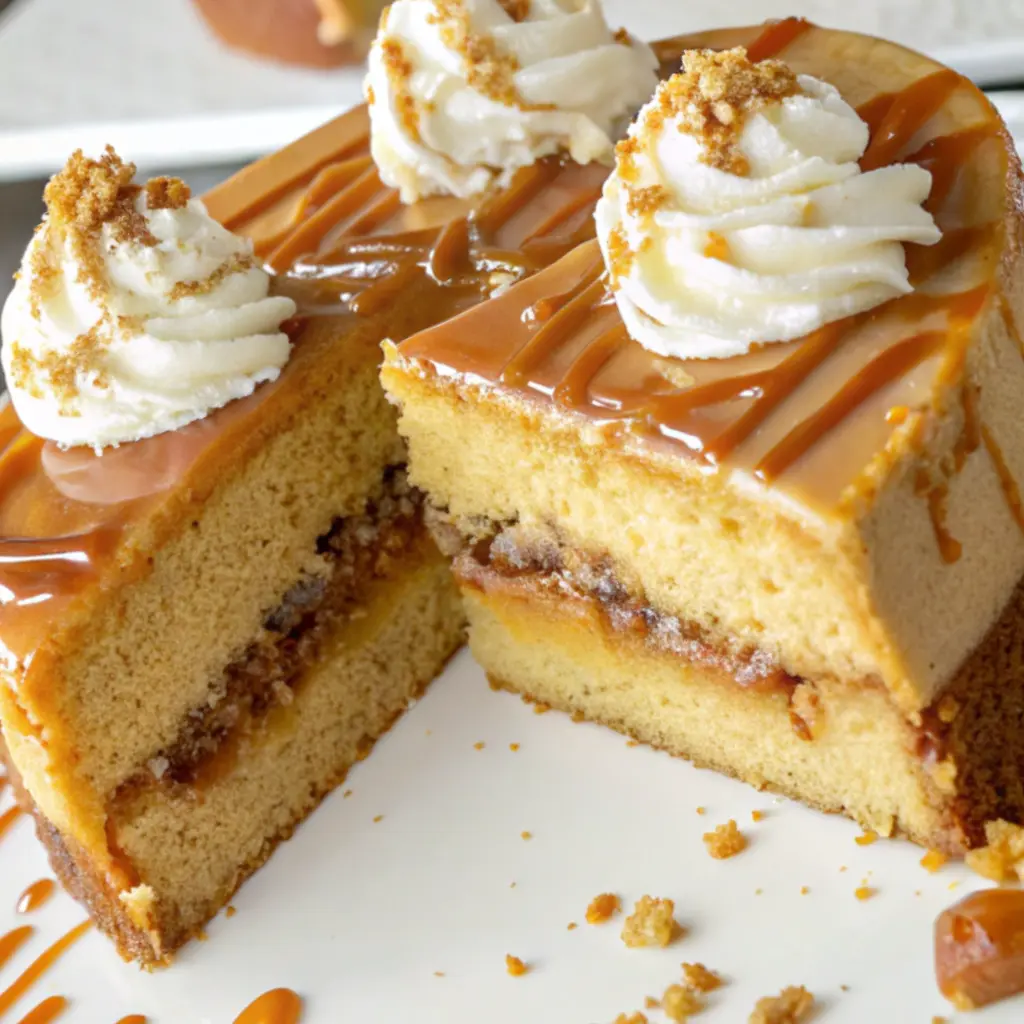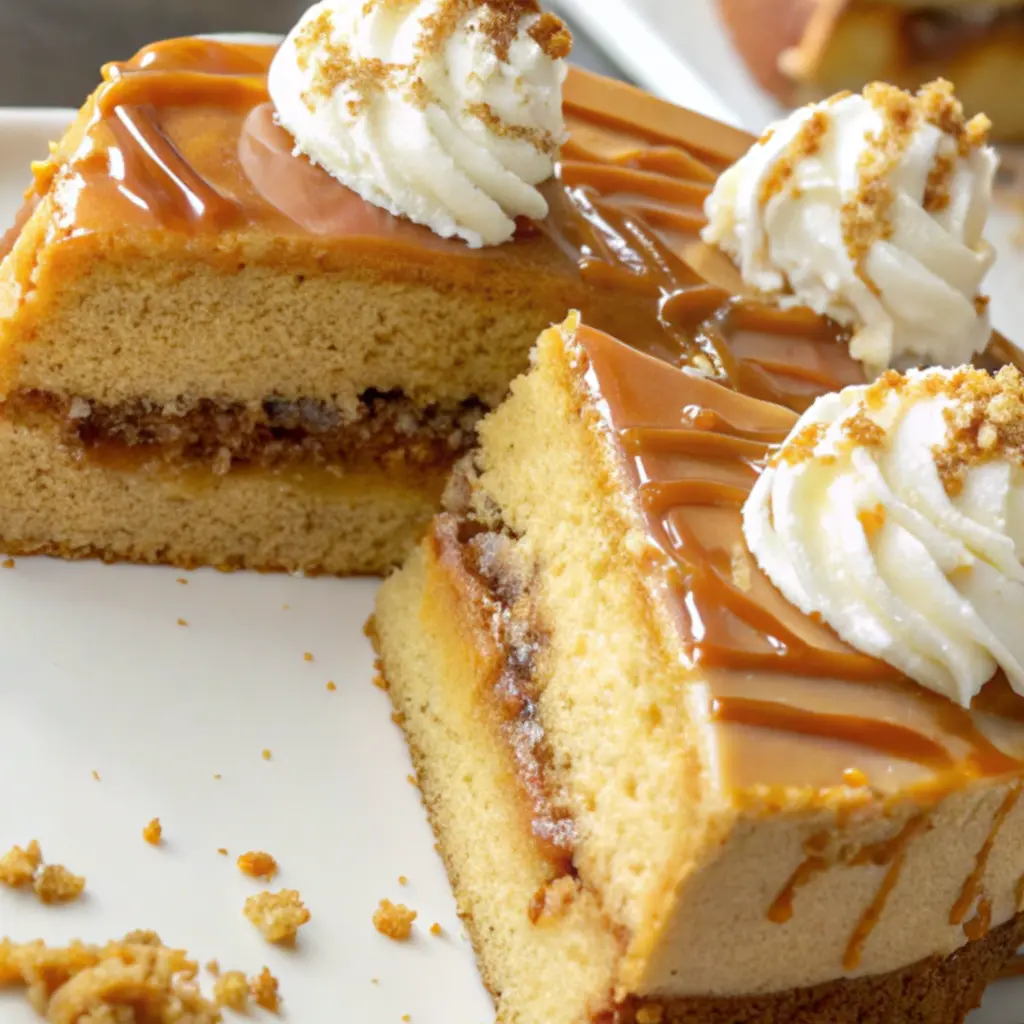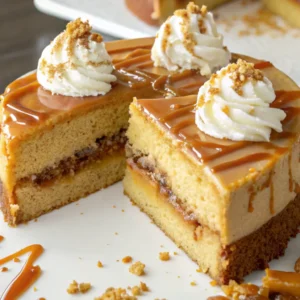The first time I made caramel cake, it was for my grandmother’s 82nd birthday. I wanted to bring something special—something that would feel like a memory, not just dessert. I remember leafing through her old recipe box, stained and softened with age, and finding a card labeled simply “Caramel Icing – for THE cake.” That’s how I knew I was on the right track. She used to make it in a sheet pan, with a dense yellow cake underneath and a thick layer of amber frosting that stuck to the knife. I’d watch her beat the caramel by hand until her arm gave out, and she’d always say, “It’s not done ‘til it looks like satin.” That memory guided me through my first few sticky, sugary attempts. I burned the caramel once, undercooked it twice, and cried when it crystallized into a grainy mess. But I kept at it. And now, years later, I make it not just to honor her, but because it tastes like comfort, like family, like every good thing that takes just a little patience.

Why You’ll Love This Recipe:
- Rich, buttery yellow cake with deep caramel flavor
- Perfect balance of sweetness and nostalgia
- From-scratch icing that feels like an old Southern tradition
- Ideal for birthdays, holidays, or family Sunday dinners
- A make-ahead cake that tastes even better the next day
Ingredients You’ll Need:
For the Cake:
- 2 ½ cups all-purpose flour (I always sift it—Grandma swore by it for a tender crumb)
- 2 ½ tsp baking powder
- ½ tsp salt
- 1 cup (2 sticks) unsalted butter, room temperature
- 2 cups granulated sugar
- 4 large eggs, room temperature
- 1 cup whole milk
- 1 tbsp vanilla extract (real vanilla if you have it—it makes all the difference)
For the Caramel Icing:
- 1 cup (2 sticks) unsalted butter
- 1 cup packed light brown sugar
- ½ cup heavy cream
- ¼ tsp salt
- 3–4 cups powdered sugar (sifted)
- 1 tsp vanilla extract
I’ve tried a few shortcuts over the years—swapping in cake flour for a lighter texture, or using half-and-half in a pinch for the icing. But nothing quite replaces the full-fat, full-flavor approach when it comes to caramel cake. It’s the kind of recipe where real ingredients shine.
How to Make It (Step-by-Step Instructions):
Start by preheating your oven to 350°F and greasing and flouring two 9-inch round cake pans. I also like to line the bottoms with parchment for insurance. Nothing ruins the mood like a stuck cake.
In a medium bowl, whisk together the flour, baking powder, and salt. Set it aside—we’ll come back to it soon.
In a large bowl, cream the butter and sugar until it’s pale and fluffy. This takes a good 4–5 minutes with a hand mixer, and it’s worth every second. Add the eggs one at a time, beating well after each. Scrape down the sides of the bowl—this batter likes to cling.
Now, alternate adding your dry ingredients and milk, starting and ending with flour. I do three additions of flour and two of milk. Stir in the vanilla last. The batter should be thick, smooth, and smell like the beginning of something good.
Divide the batter evenly between your pans and bake for about 25–30 minutes, or until the centers spring back when touched. Let the cakes cool in the pans for 10 minutes before turning them out onto wire racks. Let them cool completely. This is not a warm-cake kind of frosting—caramel waits for no one and spreads best on a cool surface.
Now, onto the icing. In a heavy saucepan, melt the butter and brown sugar over medium heat. Let it come to a gentle boil and cook for about 2 minutes, stirring constantly. Carefully stir in the cream and salt—it may bubble up a bit—and bring it back to a soft boil for another 2–3 minutes.
Remove the pan from the heat and let it cool slightly before stirring in the vanilla. Then gradually beat in the powdered sugar, one cup at a time, until the icing is thick but pourable. If it sets too quickly, you can warm it gently again or thin with a splash of cream. It should look glossy and smooth, almost like fudge before it sets.
Working quickly, spread the caramel frosting over one cooled cake layer, then place the second layer on top and cover the whole cake. It’ll firm up fast, so don’t overthink it. The slightly rustic, swirled look is part of the charm.

Expert Tips for the Best Results:
Caramel icing has a mind of its own, so keep your tools ready and don’t walk away once the sugar’s boiling. Use a heavy-bottomed pan to prevent scorching, and always sift your powdered sugar—it makes the icing smooth as silk. Let the cake cool completely before icing, and if you’re making this for a gathering, do it the night before. The flavors deepen overnight, and the icing sets just right.
Variations & Substitutions:
Sometimes I add a pinch of cinnamon to the caramel or a drizzle of salted caramel on top if I’m feeling fancy. For a twist, I’ve made it as a sheet cake and poured the warm icing over the top like a glaze. And once, during a cream emergency, I used evaporated milk in the icing—slightly different texture, but still wonderful. This cake is forgiving, as long as you’re patient with the caramel.
Serving Suggestions:
Caramel cake is the kind of dessert you serve with a pot of coffee and a full heart. It’s perfect after Sunday supper, on a holiday table, or sliced thick at a birthday gathering. I like to serve it chilled in summer and just above room temp in cooler months. Either way, it’s rich, indulgent, and deeply comforting—best shared with people who know you well.
Storage & Reheating Instructions:
This cake keeps beautifully at room temperature for a day or two, as long as it’s covered. After that, I move it to the fridge where it’ll stay good for up to five days. Just bring it to room temp before serving so the caramel softens a bit. I’ve also frozen slices individually, wrapped in wax paper and foil, for emergency cake cravings.
Recipe FAQs:
Can I use store-bought caramel sauce instead?
You could, but the texture won’t be the same. This icing sets into a soft, fudge-like layer that’s part of the whole experience.
What kind of brown sugar should I use?
I like light brown for a balanced flavor, but dark brown gives it a deeper, almost molasses-y edge. Both work—just adjust to your taste.
My icing hardened too fast—what can I do?
Add a splash of cream and gently reheat it over low heat. Stir until smooth again and keep going. Caramel is forgiving if you’re gentle.
Can I make this cake a day ahead?
Absolutely—and I usually do. It tastes even better the next day, once the flavors have had time to settle in.

Conclusion:
This caramel cake is a love letter to the recipes that came before us. It takes time, sure—but it gives back in flavor, in tradition, and in the joy of bringing people together. If you make it, I hope you feel that sense of legacy, of something passed down through hands and stories. Leave a comment if you try it, or share a memory that it reminds you of. These cakes have a way of stitching our families—and our kitchens—closer together.

Caramel Cake
Ingredients
For the Cake Layers:
- 1 cup unsalted butter softened
- 2 cups granulated sugar
- 4 large eggs
- 1 tablespoon vanilla extract
- 3 cups all-purpose flour
- 1 tablespoon baking powder
- ½ teaspoon salt
- 1 cup whole milk
For the Caramel Frosting:
- 1 cup unsalted butter
- 2 cups packed light brown sugar
- ½ cup whole milk or heavy cream
- 4 cups powdered sugar
- 1 teaspoon vanilla extract
- Pinch of salt
Instructions
- Make the cake batter: Preheat oven to 350°F (175°C). Grease and flour two 9-inch round cake pans. In a large bowl, cream the butter and sugar until light and fluffy. Add eggs one at a time, beating well after each. Stir in vanilla.
- Mix the dry ingredients: In a separate bowl, whisk together flour, baking powder, and salt. Add to the wet ingredients alternately with the milk, beginning and ending with the flour mixture. Mix just until combined.
- Bake the cakes: Divide the batter evenly between prepared pans. Bake for 28–32 minutes, or until a toothpick inserted in the center comes out clean. Cool in pans for 10 minutes, then transfer to a wire rack to cool completely.
- Make the caramel frosting: In a saucepan over medium heat, melt butter. Stir in brown sugar and cook for 2–3 minutes, stirring constantly. Add milk and bring to a gentle boil. Remove from heat and let cool slightly. Gradually beat in powdered sugar, vanilla, and salt until smooth and spreadable.
- Assemble the cake: Place one cake layer on a serving plate. Spread a thick layer of caramel frosting on top. Add the second cake layer and frost the top and sides with remaining caramel frosting.
- Serve: Slice and serve at room temperature for the best texture and flavor.
Notes
- If frosting thickens too much, add a splash of milk and re-whip until smooth.
- For extra depth, sprinkle a little flaky sea salt over the frosted cake.
- Store covered at room temperature for up to 2 days or refrigerate for longer freshness.
- Make it a three-layer cake by dividing the batter into three 8-inch pans and adjusting bake time to 22–26 minutes


Leave a Reply